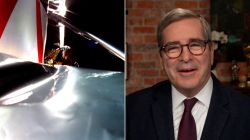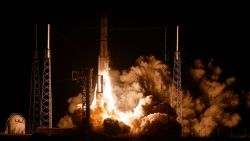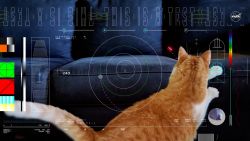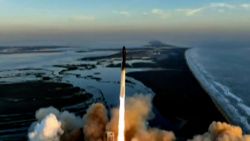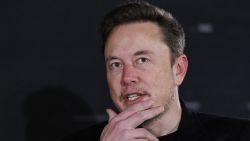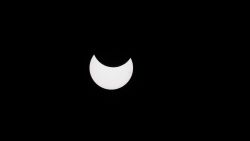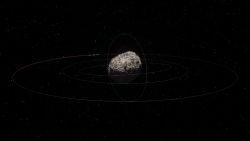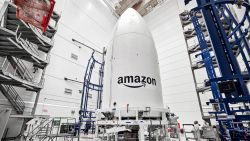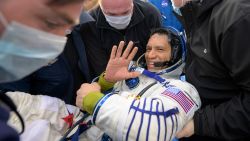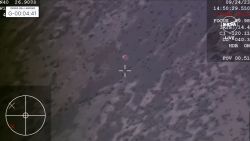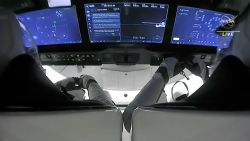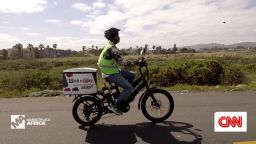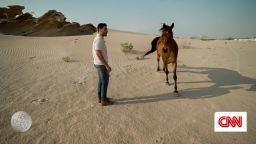Inside Access, only on CNN Business, goes behind the scenes of the world’s most innovative companies. The multimedia series went inside Richard Branson’s Virgin empire and premiered live from Mojave, California, on November 30, 2018.
Four years ago, a co-pilot was killed during a Virgin Galactic test flight. The tragedy left the future in doubt for the space tourism company and derailed its plans to begin commercial flights to the edge of space.
Hundreds of people had already reserved tickets that cost between $200,000 and $250,000. Some people lost their nerve and canceled their reservations.
But over the last few years, Virgin Galactic has righted itself. It has debuted an upgraded design of its rocket-powered plane, SpaceShipTwo, the first of which is called VSS Unity. Pilots conducted its first powered test flights earlier this year — the strongest indication yet that the company is nearing commercial operations.
“I’ve been so proud of the [Virgin Galactic] team, how they’ve responded to [the tragedy] and really moved forward with a sense of urgency,” Virgin Galactic CEO George Whitesides told CNN Business’ Rachel Crane.
“We’re about to enter into sort of the highest and fastest part of our flight test program,” he said. Galactic will conduct test flights that reach its goal altitude, more than 50 miles above Earth. “Then we’ll be in a position where we could be doing commercial service,” Whitesides said.
Branson himself plans to be the first passenger to hitch a ride aboard VSS Unity.
Exactly when passenger trips will begin is unclear. Branson, who has often touted deadlines that aren’t met, told CNN Business on Wednesday that he is “pretty confident” VSS Unity’s first flight to space will be “before Christmas.”
Orbital flight
The startup also has its eyes on the moon and beyond.
Executives says Virgin Galactic wants to eventually compete with the likes of SpaceX on more difficult and dangerous space travel goals.
“I’m talking about, potentially, orbital flight or even staying a week on a space station or going around the moon,” Whitesides, the CEO, told CNN Business. “Or going even farther than that.”
Orbital flights, which require faster speeds and specific trajectories, are not in Virgin Galactic’s near-term future. The company’s current spaceship isn’t capable of such a trek.
But Virgin Galactic executives told CNN Business they one day could work with Virgin Galactic’s sister company — Virgin Orbit, which is focused on launching small satellites — to develop new human flight capabilities.
Virgin Orbit plans to use a lightweight rocket that will launch mid-air from under the wing of a Boeing 747 to send up groups of satellites, some small enough to fit in the palm of your hand. Virgin Orbit CEO Dan Hart told CNN Business recently that he expects Orbit’s first mission to be underway by the “early part of next year.”
“When a Virgin Orbit [rocket] goes into space, it’ll be traveling at 18 and a half thousand miles an hour around the Earth,” Branson said. “Going from there to then putting people into orbit should be … a relatively sensible next step.”
Three minutes in zero gravity
Galactic’s core technology is the brainchild of Burt Rutan, an eccentric aerospace engineer who teamed up with Paul Allen, the late co-founder of Microsoft, to form Scaled Composites. In 2004, their SpaceShipOne won the $10 million Ansari X Prize, a cash-prize competition meant to spur innovation, by making two crewed trips to space within two weeks.
Virgin Galactic has since spearheaded the effort to adapt the technology for commercial flights.
This is how it will work: A carrier plane, called WhiteKnightTwo — it looks like two jets flying side by side, fused together at their wings — takes off from a runway carrying SpaceShipTwo. At about 50,000 feet the mothership releases SpaceShipTwo, and the rocket-powered plane free falls for a few seconds. Then the pilot fires the engine, heaving the craft further into the sky at three times the speed of sound.
At its peak altitude, more than 50 miles, or 264,000 feet, above Earth, passengers will be able to experience three to four minutes of weightlessness and take in sweeping views of the planet, Galactic says. From takeoff to landing, the trips will last about 1.5 hours.
Mark “Forger” Stucky, who has piloted SpaceShipTwo on more than a dozen test flights, said he takes it “very seriously” — “but I don’t feel like I’m walking the plank or, you know, flipping the coin on whether I’m going to live or not,” he said.
“You just have to do the proper quality assurance, in our case training and whatever simulations, to show that you’re safe enough,” he said.
Billionaire’s space race
Branson founded Galactic in 2004, around the same time Jeff Bezos and Elon Musk, two other deep-pocketed entrepreneurs, established space companies of their own.
More than a decade later, the commercial space industry is booming.
Musk, whose ultimate goal is to establish a human colony on Mars, is leading the charge with SpaceX. It has put more than 60 missions into orbit, without crews on board. Musk also plans to launch a trip around the moon in SpaceX’s first tourism mission as soon as 2023.
And both companies want to adapt their spaceflight technology to shuttle people around the Earth. SpaceX said last year that its forthcoming rocket technology could fly passengers from New York to Shanghai in half an hour.
Branson has long envisioned using Galactic’s technology for faster point-to-point travel on Earth.
“Obviously SpaceShipTwo is not a platform that will allow us to go from New York to London in 30 minutes,” Enrico Palermo, president of The Spaceship Company, Virgin Galactic’s manufacturing partner, told CNN Business. “But it’s on the stepping stone.”
In the nearer term, Virgin Galactic will go head-to-head with Blue Origin in offering suborbital tourism flights.
Bezos’ startup is well underway in tests of a capsule and rocket that takes off and lands vertically. The company told CNN Business it has not settled on a ticket price, but Reuters reported they will cost about as much as Virgin Galactic’s — between $200,000 and $300,000 each.
Blue Origin has not yet set a date for its first commercial flight.
Risky business
Aerospace companies face daunting risks. The history of human spaceflight is one of triumphs and tragedies. The deadliest were the Space Shuttle disasters of 1986 and 2003, which each claimed lives of all seven astronauts on board.
“We think a lot about risk in this company, and we know that we will not have a business if we do not have a product that we feel confident flying on ourselves,” Whitesides said.
The chief executive has skin in the game — he’s purchased tickets for himself and his wife.
But, he added, “If we don’t take any risks, we’re not going to advance.”
Whiteside said he hopes space tourism will set off a contagion of the “overview effect” — a phenomenon that astronauts have described as a profound shift in one’s worldview after seeing the Earth from afar.
“You look at climate change, or you look at certain peace and security issues, these are issues that cannot be handled just by one country or one city,” he said. “They’re issues that have to be handled at a really a global scale.”
Correction: A previous version of this story misstated the title of Enrico Palermo.



